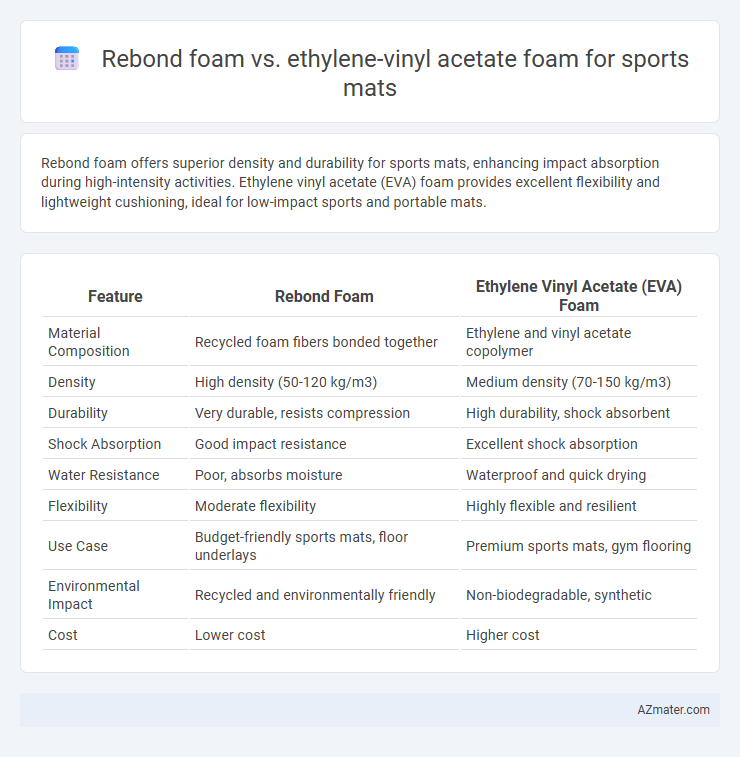Rebond foam offers superior density and durability for sports mats, enhancing impact absorption during high-intensity activities. Ethylene vinyl acetate (EVA) foam provides excellent flexibility and lightweight cushioning, ideal for low-impact sports and portable mats.
Table of Comparison
| Feature | Rebond Foam | Ethylene Vinyl Acetate (EVA) Foam |
|---|---|---|
| Material Composition | Recycled foam fibers bonded together | Ethylene and vinyl acetate copolymer |
| Density | High density (50-120 kg/m3) | Medium density (70-150 kg/m3) |
| Durability | Very durable, resists compression | High durability, shock absorbent |
| Shock Absorption | Good impact resistance | Excellent shock absorption |
| Water Resistance | Poor, absorbs moisture | Waterproof and quick drying |
| Flexibility | Moderate flexibility | Highly flexible and resilient |
| Use Case | Budget-friendly sports mats, floor underlays | Premium sports mats, gym flooring |
| Environmental Impact | Recycled and environmentally friendly | Non-biodegradable, synthetic |
| Cost | Lower cost | Higher cost |
Introduction to Sports Mat Materials
Rebond foam and Ethylene Vinyl Acetate (EVA) foam are popular materials used in sports mat construction, offering distinct performance characteristics. Rebond foam, made from recycled scrap foam bonded together, provides exceptional density and shock absorption, making it ideal for high-impact activities. EVA foam delivers lightweight cushioning with excellent flexibility and water resistance, often preferred for gymnastics and martial arts mats where comfort and durability are crucial.
What is Rebond Foam?
Rebond foam is a durable material created by bonding shredded foam scraps with adhesive under high pressure, resulting in a dense, firm cushion ideal for high-impact sports mats. Ethylene vinyl acetate (EVA) foam offers a softer, more flexible alternative with excellent shock absorption and water resistance but lower density compared to rebond foam. Rebond foam's superior weight support and resilience make it the preferred choice for heavy-duty athletic flooring requiring long-lasting performance.
What is Ethylene Vinyl Acetate (EVA) Foam?
Ethylene Vinyl Acetate (EVA) foam is a soft, durable, and flexible material commonly used in sports mats for its excellent shock absorption and cushioning properties. It consists of a closed-cell structure that provides resistance to water, UV radiation, and chemicals, making it ideal for both indoor and outdoor use. EVA foam offers superior comfort and protection for high-impact activities compared to rebond foam, which is denser and less elastic.
Durability Comparison: Rebond Foam vs EVA Foam
Rebond foam offers superior durability for sports mats due to its high-density composition made from recycled foam scraps, providing excellent resilience and resistance to compression over time. Ethylene vinyl acetate (EVA) foam, while lightweight and shock-absorbent, tends to degrade faster under heavy use because of its softer structure and susceptibility to tear and wear. For long-lasting sports mats, rebond foam is preferred in high-traffic areas requiring consistent cushioning and durability.
Cushioning and Shock Absorption Properties
Rebond foam offers superior cushioning and shock absorption due to its dense composition made from shredded foam bonded together, providing excellent impact resistance for sports mats. Ethylene vinyl acetate (EVA) foam delivers lightweight, flexible cushioning with moderate shock absorption, making it ideal for activities requiring softer, more responsive surfaces. For sports mats requiring maximum protection and durability, rebond foam excels, whereas EVA foam prioritizes comfort and agility.
Weight and Portability Factors
Rebond foam, made from recycled polyurethane scraps, is denser and heavier than ethylene vinyl acetate (EVA) foam, which impacts the overall weight and portability of sports mats. EVA foam offers superior lightweight properties and flexibility, making it easier to transport and store, especially for activities requiring frequent mat movement. The choice between rebond and EVA foam significantly affects the ease of handling and convenience for athletes and fitness enthusiasts.
Water and Moisture Resistance
Rebond foam offers moderate water resistance but tends to absorb moisture over time, leading to potential degradation and odor buildup in sports mats. Ethylene vinyl acetate (EVA) foam provides superior water and moisture resistance due to its closed-cell structure, preventing water absorption and ensuring durability in wet environments. For sports mats exposed to moisture, EVA foam maintains performance and hygiene better than rebond foam.
Safety and Skin-Friendliness
Rebond foam offers exceptional shock absorption and durability, making it safer for high-impact sports mats by reducing injury risk. Ethylene vinyl acetate (EVA) foam provides superior skin-friendliness with its soft, non-toxic, and hypoallergenic properties, minimizing irritation during prolonged contact. Both materials ensure safety but differ in texture and comfort, with rebond foam excelling in impact protection and EVA foam in skin sensitivity.
Cost and Value Considerations
Rebond foam typically offers a lower cost per square foot compared to Ethylene Vinyl Acetate (EVA) foam, making it a budget-friendly option for sports mats without sacrificing durability. EVA foam provides superior shock absorption and resilience, which can justify its higher price for athletes requiring enhanced performance and safety. Evaluating the balance between upfront cost and long-term value is crucial, as rebond foam mats may need replacement sooner than EVA, impacting overall investment efficiency.
Choosing the Right Foam for Your Sports Mat
Rebond foam offers superior density and durability, making it ideal for high-impact sports mats requiring maximum shock absorption and long-term resilience. Ethylene vinyl acetate (EVA) foam provides lightweight cushioning with excellent flexibility and water resistance, suitable for mats emphasizing comfort and ease of maintenance. Selecting the right foam depends on balancing durability needs with comfort preferences, where rebond foam excels in heavy-use scenarios and EVA foam suits versatile, low-impact activities.

Infographic: Rebond foam vs Ethylene vinyl acetate foam for Sports mat
 azmater.com
azmater.com